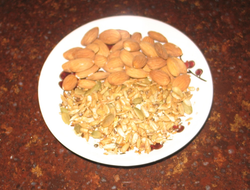Vitamin E: An essential vitamin, but not age defying
Published: May 06, 2022
Nuts and seeds are good sources of vitamin E, but what is vitamin E?
As a fat soluble vitamin, vitamin E can be stored in small amounts in the fatty tissues of your body.
Functions
Vitamin E has several important functions in your body such as maintaining the stability of your body cells and the integrity of cell membranes.
In particular, it is thought that vitamin E’s antioxidant properties prevent the oxidation of unsaturated fatty acids which are integral to the cells of your body.
Oxidation of these unsaturated fatty acids results in damage to cell membranes leading to structural and functional weakness.
For example, structurally sound cell membranes are required for glucose transport and metabolism in cells.
When cell membranes do not function as they should glucose, a primary source of energy for all cells, may not be transported into cells and will not be available for energy metabolism.
Antioxidant activity is particularly important in tissues which are exposed to oxygen such as lungs, brain and erythrocytes (blood cells) which have a high polyunsaturated fatty acid content.
As an antioxidant, vitamin E is a primary defender against adverse effects of free radicals by stopping the chain reaction of free radical production.
This action appears to protect components of cells and cell membranes which are susceptible to oxidation and frequently occurs in conjunction with the activity of other nutrients which exhibit antioxidant activity such as:
- vitamin C
- glutathione
- carotenoids
- enzymes which require trace elements such as iron, selenium, copper, zinc and manganese.
In particular, vitamin E and vitamin C appear to have a synergistic relationship with respect to oxidation inhibition.
Vitamin E activity may inhibit synthesis of cholesterol, suppress tumour cell growth, and reduce your risk of...link to the full article to learn more.
References
1.
Whitney, E. & Rady Rolfes, S. (2005). Understanding Nutrition. Belmont, CA: Thomson Wadsworth
2.
Gropper, S.S., Smith, J.L. & Groff, J.L. (2005). Advanced Nutrition and Human Metabolism (4thEd.). Belmont, CA: Thomson Wadsworth.

